Saturday morning, K, J, B and I took a taxi to Bishkek’s Osh Bazaar, from where
we were able to hire a car to take us to Osh – the second biggest city in
Kyrgyzstan, located in the south-west of the country near the border with
Uzbekistan – for 5000som total, which was a pretty fair cost from what we’d
been told to expect. It took us nine hours, and brought us through a wide
variety of scenery, much of which was quite different from the typical scenery
up here in the northern part of the country.
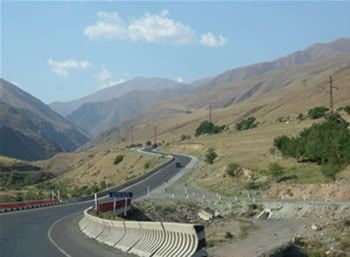
The road began to get interesting just south of Kara Balta.
I’d say the most interesting point of the trip was seeing firsthand the
depletion of the Toktogul Reservoir, which is Kyrgyzstan’s biggest source of
water and hydroelectric power… It is obviously much lower than it should be.
The eastern edge of the reservoir is nearly bone dry, and while the larger
western half is still quite full, the water level is far below the previous
water line. That doesn’t bode well for Kyrgyzstan’s future.

The eastern end of the Toktogul Reservoir is bone dry.

Luckily there's still a lot of water in the larger western end.
You can clearly make out the previous water line though.
Following the reservoir, the Naryn River is funneled into a series of smaller
reservoirs in a picturesque canyon, and they seem quite full, so perhaps things
aren’t quite as bad as some estimates suggest. Nonetheless, country-wide
rolling blackouts have started again in preparation for the coming winter.
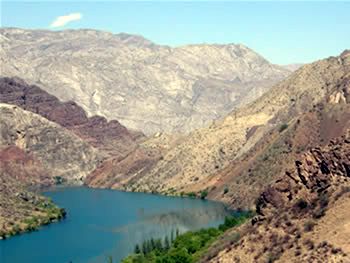
One of the many Naryn River reservoirs.
Once we got out of the mountain passes and entered the eastern edge of the
Ferghana Valley, the scenery became much less interesting: flat and hot. To me,
the most remarkable aspect of south-western Kyrgyzstan was the lack of Ladas
and other Soviet era cars and the sheer preponderance of Korean Daewoo Ticos,
which as far as I knew were no longer produced, having been replaced by the
Daewoo Matiz. There were Ticos *everywhere* (and a fair share of Matizes and
other Daewoo models as well). Now, Bishkek has a high population of Koreans,
but we didn’t run across any Koreans down south. But there were Korean cars all
over the place… and I bought a lime green Jumong t-shirt in the Jayma Bazaar.
Curiouser and curiouser. [According to wikipedia, there is a Daewoo plant
just over the border in Uzbekistan, which goes a long way
to explaining this madness.]
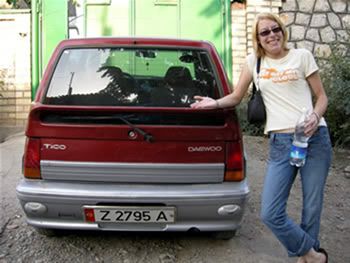
Why all the Daewoo Ticos???
When we finally arrived in Osh, we had a bit of difficulty finding our way to
our CBT homestay as it was located on a tiny, obscure street in a far corner of
the city. While the house itself was certainly the most luxurious house I’ve
been inside here in Kyrgyzstan, and while the owners were nice, there weren’t
enough beds, despite our reservations. Plus it was 750som/night/person, which
is incredibly expensive for Kyrgyzstan. We were a little disappointed.
Nonetheless, we unloaded our stuff and headed into the town center. After a
short after hours walk around the famous Jayma Bazaar, we found our way to a
nice café for some shashlik, then returned to our homestay. While we didn’t
spend much time in the city, we found the people friendly, and we felt that
even though there wasn’t much to the city, it had far more character than
Bishkek.
The next morning we said goodbye to Ben as he set off on his solo adventure to
Uzbekistan and Tajikistan, and the three of us headed to the Osh center in search
of cheaper accommodation. J found a place called Stari Gorod located on the
corner of Kyrgyzstan and Zainabetinova streets which rents fully furnished
apartments for reasonable fees. They have both new/modern apartments and older
more Soviet style places. We rented a Soviet apartment in the center for
900som/night total (so 300som/person) which was an excellent deal. After
leaving our stuff in our new home, we set off to explore the Jayma Bazaar on
its busiest day of the week.
Jayma Bazaar is far more impressive than Bishkek's Osh Bazaar, and it lacks the
seedy air of the Bishkek bazaar. Plus, even though there is no ancient
architecture whatsoever, it was rather awe-inspiring to think that there has
been a bazaar in that location for roughly 3000 years. All of the vendors were
incredibly friendly, (although no one guessed that we were from America/Canada
– I got asked if I was German, Czech, Belgian and even Spanish!) and they were
nice to talk to and willing to be photographed. I bought two scarves, the
aforementioned lime-green Jumong t-shirt, and an orange bridle. The man who
sold me the bridle and I got along quite well once we determined we shared the
view that George Bush was a svolich. Awesome.
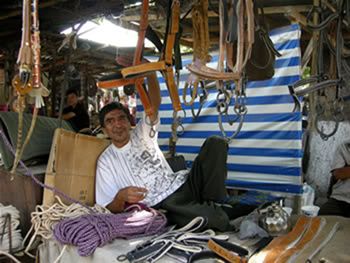
The fellow who sold me the bridle.
We left the bazaar and made our way to Suleiman Too (Solomon Mountain, commonly
called Solomon’s Throne in guidebooks). This mountain is revered as Muhammad
supposedly prayed atop it. Additionally, people claim that the mountain
resembles a reclining pregnant woman (although unless she’s planning to give
birth to a very pointy baby, I don’t see it), so pregnant women and hopeful
mothers frequently make the pilgrimage to the top to pray.

I just don't see a pregnant woman.
The climb to the top is steep, although the path consists of fairly new
concrete steps with a rail, so it is not difficult and only takes about 15
minutes. Nonetheless, by the time we reached the top we were drenched in sweat
and feeling rather miserable. From atop Suleiman Too you can see an aerial view
of Osh, and that’s essentially it. There’s a small mosque at the summit, but it
is a new structure and not too interesting. While Suleiman Too is the main “attraction”
of Osh, there’s not much to it.
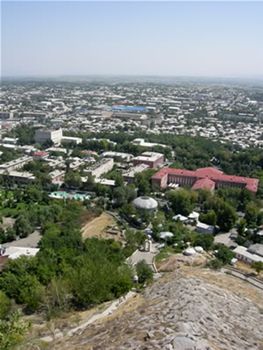
The view from atop Suleiman Too
After hiking back down and snagging some lunch, we rested in our apartment for
a little while, then made our way to a nice park next to the “river” (more of a
canal, in my opinion) that runs through the city. The park was a tree-lined
pedestrian avenue filled with people out for an afternoon stroll, and there
were many small cafes. Additionally, there were numerous ancient amusement park
rides which were obviously very popular with people of all ages. At the end of
the park sits an old Soviet-era Aeroflot plane which somehow used to serve as a
video theater. The plane is at the base of a fountain which would make for
excellent morning photography, but is impossible to shoot from the front in the
late afternoon. After dining at a cheap café in the park, we returned to our
apartment and spent the remainder of the day relaxing.
The next morning we arose early and headed to the bus station near the bazaar
in order to catch a marshrutka (a van which passes for public transport in this
country) to Jalalabad. The ride cost 100som/person and only lasted an hour and
forty-five minutes, but was thoroughly uncomfortable. We got the last three
seats on the marshrutka. I had a normal seat, but with someone’s child in my
lap. J got a tiny stool in the aisle. K was squished into a tiny spot next to
the fattest woman in all of Kyrgyzstan. By the time we reached Jalalabad, none
of us was in the mood to attempt a marshrutka to our next destination.
After a quick lunch at the bus station, we negotiated a taxi from Jalalabad to
Arslanbob. We got it for 1000soms (although it’s much cheaper if you go via
public transport), and our driver got us all the way to Arslanbob in less than
an hour. (He was a little mad; his method of dealing with obstacles such as
pedestrians and livestock was to lean on both the horn and the gas at the same
time and hope that whatever was in our way moved.)
Arslanbob is a picturesque village located in the mountains north of Jalalabad,
and it’s known for having the largest walnut grove in the world. It’s also
predominantly Uzbek. The scenery, forest-land and culture of the village made
it seem almost as though we were no longer in Kyrgyzstan. It reminded me of a
bizarre combination of Taos, New Mexico and an ocean-less Costa Rica. It might
very well be my favorite place in Kyrgyzstan.

The view from our CBT homestay in Arslanbob
Our CBT homestay (for the fabulous price of 350som/person/night) was located at
the upper edge of the valley, and we had a balcony with a spectacular view,
which was an excellent place for a nap :-) Our host family spoke mainly Uzbek,
with a smattering of Russian and even less English. Uzbek is quite similar to
Kyrgyz (in the way that Spanish and Italian are similar), so we were able to
communicate using the few Kyrgyz words that we knew. They were incredibly
friendly, wonderful people. There was also a super tolerant cat, an incredibly
lazy dog, and a beautiful flower garden. [Side note on pronunciation: A few of
the differences I was able to notice with my pathetic Kyrgyz skills – jok (no)
is pronounced yok, and jeti (seven) is pronounced yeti, and saat (hour/time) is
pronounced sahat.]
After napping on our wonderful balcony, we decided to head into the village
center for some refreshment. We had tea and samsa at an incredible tea house
with balconies overhanging the river. The tea house was apparently the hang-out
for the old men of the village, and I felt rather out of place as both a
foreigner and a woman, but we were treated kindly by everyone there.
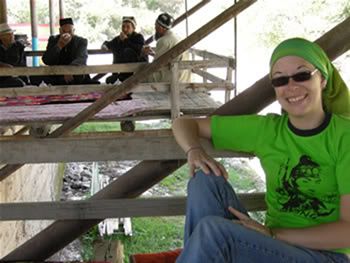
Me in the Arslanbob tea house
After finishing out tea, we made for Arslanbob’s small waterfall, which is a
fairly short walk from the village. The afternoon was hot and sunny, and the
waterfall was gorgeous and cool. K and I merely soaked our feet, whereas J did
like many of the locals and stood under the frigid falls himself. Several
locals came to the falls, not just too cool off, but to bathe/shave while we
were there. Many Kyrgyz tourists came to the falls to be photographed. Some
were brave enough to venture into the frigid waters… including one very scary
large man wearing nothing but tighty-whities. Additionally, like Suleiman Too,
the small waterfall of Arslanbob is surrounded by some sort of fertility myth
and is visited by pregnant women and those wishing to become pregnant. K and I
obstinately sat on cold rocks (a belief introduced into this region by the
Russians that such behavior will cause your ovaries to freeze).
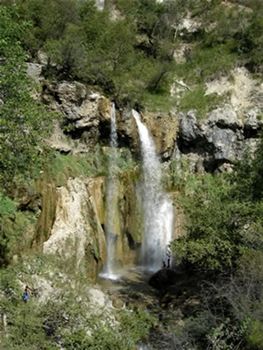
Arslanbob's small waterfall
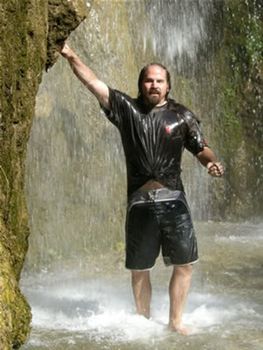
J in the waterfall.
After leaving the waterfall, we wandered around the village for a couple of
hours before returning to our homestay for a wonderful dinner of home-cooked
plov.
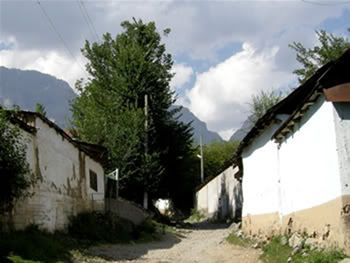
Typical Arslanbob street
The next morning we got up fairly early, and after breakfast set off on what
ended up being a rather lengthy hike. First we hiked back to the small
waterfall. From the top of the small waterfall, if you take the trail farthest
to the right it will lead you to a panoramic view of the village and the
valley. We went there first and snagged some pleasant shots before it got too
hot.
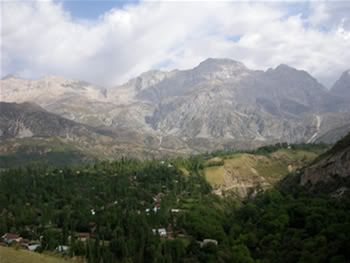
View from the panorama
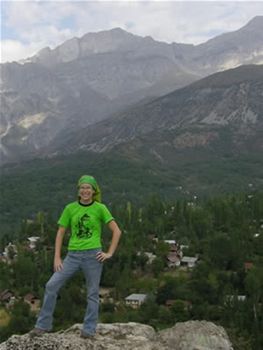
Me at the panorama
Leaving the panorama, the trail is dusty and covered with small rocks. I lost
traction and totally wiped out, crashing quite solidly onto the rocky ground.
Apparently my instinct is to save my camera at all costs, for in the split
second between losing my footing and slamming into the ground I managed to
direct the force of my fall onto my left side while holding my camera free and
clear of the catastrophe in my right hand. I was bleeding in several places and
my hip ached tremendously from that moment onwards (it has since developed
quite a spectacular bruise), and it took me a few minutes to stand up. As I sat
there wiping off the blood and dirt, a young woman came by herding cows... and
they lost their footing in the same place I had, and nearly slid onto me!
Luckily they didn’t, although who dies from having a falling cow push them into
a ravine? At least that would’ve left J and K with an interesting tale to tell.
No physical harm.
After I was on my feet again we continued on and soon thereafter made it into
the famed walnut forest. There were dirt “roads” through the forest, so we
never felt as though we’d left civilization, although it was beautiful, shady
and cool. When we emerged from the forest we were still feeling fairly
energetic, and we decided to try for the large waterfall, despite the fact that
we didn’t know exactly how to get there and we’d heard that it wasn’t all that
spectacular. We took two rather lengthy detours in quite incorrect directions,
and were feeling exhausted by the time we finally got on the right track for
the falls. We could see it in the distance in all its non-impressive glory, and
I for one was not encouraged by the sight of it. Or the vast distance between
it and myself. I found a shady spot by the river and decided to stay there as J
and K continued onwards… but in the end J and K also decided to give up the
quest for the big falls.
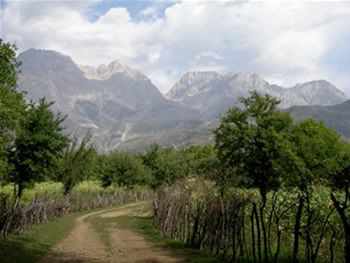
The views around Arslanbob were incredible!
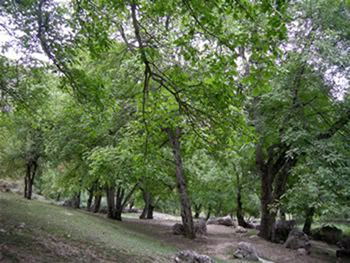
Walnut forest
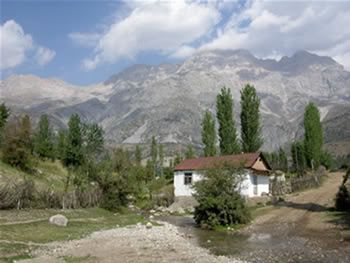
I took a ton of photos of this house.
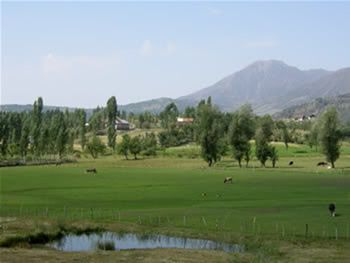
Ahhh, paradise!

That was the big waterfall. I just couldn't bring myself to go the distance.
After resting for a while (oddly enough, chatting with a couple we’d met at our
first homestay in Osh who had picked the same shady spot to rest), we turned
and made our way back to the village. K and J headed first to the small
waterfall for a “shower” although I was in pain at that point and decided to
seek out the cat for a nap. We had a fairly lazy afternoon/evening, but after
all our trekking about in the first half of the day, we weren’t up for much
else. And Arslanbob is the perfect place to relax.
The next morning, K and I said goodbye to J (who is now off to explore
Tajikistan and Afghanistan) and hopped in a taxi for Bishkek, which we shared
with two travelers (from Scotland and the Netherlands) who had also stayed at
our homestay. The taxi was 1250som/person direct from Arslanbob to Bishkek, which
should have been a good deal… but he was an odd fellow. When it came to
navigating high, narrow, winding mountain roads filled with hairpin turns, he
was a pro, keeping the gas pedal pressed to the floor while passing three cars
at a time on blind uphill turns in the grand tradition of Kyrgyz drivers.
However, the instant we got onto a flat, straight, traffic-less stretch of road
– the ideal place for speeding – he would drop to 60kph and just crawl along. I
felt like beating my head against a wall. Or offering to drive. It should have
taken us only seven hours to make it back to Bishkek, but instead it took us
nine with this weirdo. I simply cannot wrap my head around how someone who
could drive so fearlessly through the dangerous mountain passes could then poke
along like a half-blind grandmother on the straight stretches. Beyond
comprehension.
Anyway, we got back safely, after having had a wonderful vacation. If any of
you are ever in Kyrgyzstan, I highly recommend Arslanbob. The scenery is
spectacular and different from the rest of the country, the people are
incredibly friendly, and the CBT homestays are fantastic.

Well captured the moments. Helping a lot for my upcoming travel to arslanbob. Thanks
ReplyDelete